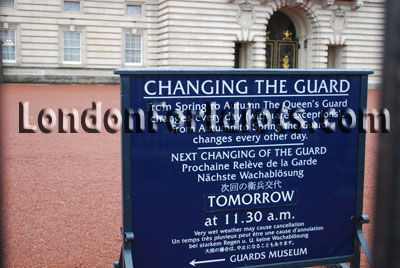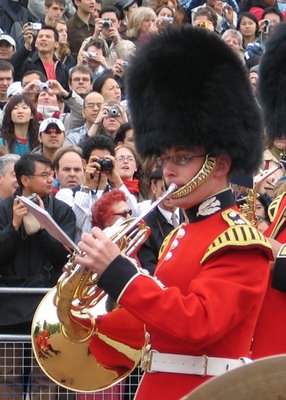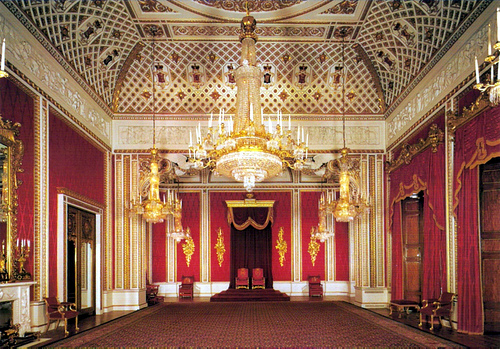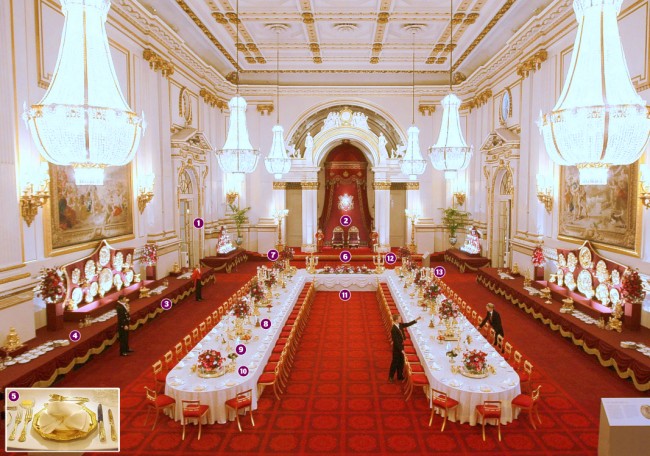
Buckingham Palace:
Buckingham Palace has served as the official London residence of Britain's sovereigns since 1837 and today is the administrative headquarters of the Monarch. Located in the City of Westminster, the palace is a setting for state occasions and royal hospitality, and a major tourist attraction.
Buckingham Palace has 775 rooms. These include 19 State rooms, 52 Royal and guest bedrooms, 188 staff bedrooms, 92 offices and 78 bathrooms. In measurements, the building is 108 metres long across the front, 120 metres deep (including the central quadrangle) and 24 metres high.

History :
In the Middle Ages, Buckingham Palace's site formed part of the Manor of Ebury (also called Eia). The marshy ground was watered by the river Tyburn, which still flows below the courtyard and south wing of the palace. Ownership of the site changed hands many times; owners included Edward the Confessor and his queen consort Edith of Wessex in late Saxon times, and, after the Norman Conquest, William the Conqueror. William gave the site to Geoffrey de Mandeville, who bequeathed it to the monks of Westminster Abbey.
 |
In 1531, Henry VIII acquired the Hospital of St James (later St. James's Palace) from Eton College, and in 1536 he took the Manor of Ebury from Westminster Abbey. These transfers brought the site of Buckingham Palace back into royal hands for the first time since William the Conqueror had given it away almost 500 years earlier.
Various owners leased it from royal landlords. By then, the old village of Eye Cross had long since fallen into decay, and the area was mostly wasteland. Needing money, James I sold off part of the Crown freehold but retained part of the site on which he established a 4-acre (16,000 m2) mulberry garden. In the late 17th century, the freehold was inherited from the property tycoon Sir Hugh Audley by the great heiress Mary Davies.
Buckingham Palace became the principal royal residence in 1837, on the accession of Queen Victoria, who was the first monarch to reside there as her predecessor William IV had died before its completion. While the state rooms were a riot of gilt and colour, the necessities of the new palace were somewhat less luxurious. For one thing, it was reported the chimneys smoked so much that the fires had to be allowed to die down, and consequently the court shivered.
|
Ventilation was so bad that the interior smelled, and when a decision was taken to install gas lamps, there was a serious worry about the build-up of gas on the lower floors. It was also said that the staff were lax and lazy and the palace was dirty. Following the Queen's marriage in 1840, her husband, Prince Albert, concerned himself with a reorganisation of the household offices and staff, and with the design faults of the palace. The problems were rectified by the end of 1840.
 |
By 1847, the couple had found the palace too small for court life and their growing family, and consequently the new wing, was built enclosing the central quadrangle. The large East Front facing The Mall is today the "public face" of Buckingham Palace and contains the balcony from which the Royal Family acknowledge the crowds on momentous occasions and annually after Trooping the Colour. Buckingham Palace was frequently the scene of lavish costume balls, in addition to the routine royal ceremonies, investitures and presentations.
Widowed in 1861, the grief-stricken Queen withdrew from public life and left Buckingham Palace to live at Windsor Castle, Balmoral Castle, and Osborne House, leaving the palace in neglect. Public opinion forced her to return to London. Court functions were still held at Windsor Castle rather than at the palace, presided over by the sombre Queen habitually dressed in mourning black while Buckingham Palace remained shuttered for most of the year. In 1901 the accession of Edward VII saw new life breathed into the palace.
|
The present forecourt of the Palace, where Changing the Guard takes place, was formed in 1911, as part of the Victoria Memorial scheme.
The gates and railings were also completed in 1911; the North-Centre Gate is now the everyday entrance to the Palace, whilst the Central Gate is used for State occasions and the departure of the guard after Changing the Guard.
During World War I the palace, then the home of King George V and Queen Mary, escaped unscathed. Its more valuable contents were evacuated to Windsor but the Royal family remained in situ.
The palace fared worse during World War II; bombed no less than seven times, the most serious and publicised of which resulted in the destruction of the palace chapel in 1940. One bomb fell in the palace quadrangle while King George VI and Queen Elizabeth were in residence, and many windows were blown in and the chapel destroyed.

Today, Buckingham Palace is not only the weekday home of the Queen and Prince Philip but also the London residence of the Duke of York and the Earl and Countess of Wessex. The palace also houses the offices of the Royal Household and is the workplace of 450 people. During the summer, visitors can tour the nineteen State Rooms, which form the heart of the Palace. These magnificent rooms are decorated with some of the greatest treasures from the Royal Collection, including paintings by Rembrandt, Rubens and Canaletto and sculpture by Canova.
This year marks the 60th anniversary of the formation of the modern Commonwealth. In 1949 the London Declaration recognised the British Monarch as the symbol of the free association of independent member nations and as Head of the Commonwealth. In celebration of this event, a special exhibition at this year’s Summer Opening of Buckingham Palace will evoke some of the most important Commonwealth tours undertaken by The Queen during her reign and show the close links maintained by Her Majesty with this remarkable international organisation and its 1.8 billion inhabitants.

What to see
See some of the greatest treasures from the Royal Collection, plus the spectacular The Queen's Coronation 1953 exhibition, featuring royal dresses, uniforms and jewellery.
The State Rooms form the heart of the working palace and are lavishly furnished with some of the finest treasures from the Royal Collection - paintings by Rembrandt, Rubens, Poussin, Canaletto; sculpture by Canova; exquisite examples of Sevres porcelain, and some of the finest English and French furniture in the world.
The Palace's 39-acre garden is an oasis for wildlife, and visitors can enjoy a garden walk that offers superb views of the Garden Front of the Palace and the 19th-century lake.
The Queen's Coronation 1953 Exhibition
This year's special exhibition at Buckingham Palace marks the 60th anniversary of The Queen's coronation in 1953. The palace's ballroom will be transformed into the largest-ever exhibition about this historic event. Objects on display include:
- The Queen's white satin coronation dress, designed by Norman Hartnell
- The Queen's Robe of Estate, made from English purple silk, which is more than 6.5 metres long
- The Diamond Diadem, one of The Queen's most recognisable jewels, which she is pictured wearing on postage stamps and some banknotes
As you tour the palace, you'll see many more items related to the coronation. For example the State Dining Room will be dressed to evoke the Coronation Banquets held on the evenings of 3 and 4 June 1953, with magnificent settings of porcelain, silver-gilt and flowers.
Opening times & admission prices
Summer opening times
The State Rooms, Buckingham Palace
27 July -31 August 2013
Open daily 09:30-19:00
(last admission 16:45)
1-29 September 2013
Open daily 09:30-18:30
(last admission 15:45)
A typical visit lasts between 2 and 2½ hours
Admission prices (all include an audio tour)
The State Rooms, Buckingham Palace
Adult £19.00
Over 60/ Student (with valid ID) £17.50
Under 17 £10.85
Under 5 Free
Family £50.00 (2 adults and 3 under 17s)
The State Rooms and Garden Highlights Tour
The State Rooms, Buckingham Palace and a Garden Highlights Tour
Adult £27.75
Over 60/ Student (with valid ID) £25.50
Under 17 £16.35
Under 5 Free
Family £74.00 (2 adults and 3 under 17s)
Admission prices for groups (15+)
The State Rooms, Buckingham Palace
Adult £17.10
Over 60/ Student (with valid ID) £15.75
Under 17 £9.75
Under 5 Free
The State Rooms and Garden Highlights Tour for groups (15+)
The State Rooms, Buckingham Palace and a Garden Highlights Tour
Adult £25.00
Over 60/ Student (with valid ID) £22.95
Under 17 £14.75
Under 5 Free
A Royal Day Out
This ticket gives admission to three sites: The State Rooms, the Royal Mews and The Queen's Gallery at Buckingham Palace.
Adult £33.25
Over 60/ Student (with valid ID) £30.50
Under 17 £18.85
Family £87.00 (2 adults and 3 under 17s)
Exclusive Evening Tour of the State Rooms, Buckingham Palace
In the company of an expert guide, enjoy the splendour of the State Rooms on an after-hours tour of Buckingham Palace.
Please note the price includes a glass of champagne, a copy of the official guidebook and 20% discount in the shop.
Adult £70.00
Nearest Underground Stations:Victoria, Green Park and Hyde Park Corner (Victoria/ Piccadilly/ Jubilee/ Circle & District lines)
During visits, all visitors and their belongings will be subject to security checks. Photography, video recording, filming, smoking and eating are not permitted inside the buildings. Mobile phones should also be switched off.
|